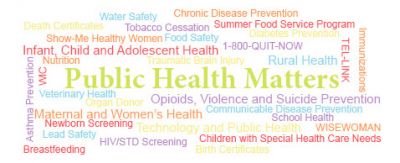
Making the Healthy Choice the Easy Choice
Why should I care?
Chronic diseases such as heart disease and diabetes are among the most common and costly health conditions impacting the nation’s health. As of 2014, 60 percent of U.S. adults were living with at least one chronic health condition and 42 percent were living with multiple chronic conditions. Such conditions account for seven out of every 10 deaths annually, while managing and treating chronic disease eats up more than three-quarters of the country’s health care costs. For example, in 2012, direct medical costs related to diabetes came to $176 billion, while lost productivity due to diabetes came to $69 billion.
But here’s the catch: Chronic diseases are often entirely preventable. Far from being inevitable, chronic diseases are associated with unhealthy and risky behaviors. And those behaviors are often shaped by the environments in which we live, work, learn and play. That means there are a variety of innovative and proven ways to make it easier for people to adopt healthy behaviors, make healthier choices and prevent the onset of costly chronic diseases.
What behaviors lead to chronic disease?
Just four behaviors are at the root of a large portion of the nation’s chronic disease burden. Those behaviors are: physical inactivity, poor eating habits, tobacco use, and alcohol consumption. For example:
• In 2016, nearly half of U.S. adults did not meet recommended guidelines for weekly physical activity.
• Even though a diet full of fruits and vegetables helps reduce chronic disease risk, only about 9 percent of adults met recommended intakes for vegetables in 2015 and about 12 percent met recommended intakes for fruit. U.S. children don’t eat enough fruits and vegetables, either.
• Despite dramatic declines in the U.S. smoking rate, cigarette use remains the leading cause of preventable disease and death in the nation. As of 2015, more than 36 million U.S. adults still smoked cigarettes. Also, electronic cigarette use among youth has tripled in recent years, exposing them to the harms of nicotine and the risk of addiction.
• In 2015, more than a quarter of U.S. adults engaged in binge drinking in the previous month. Also, about 15 million adults had an alcohol use disorder.
How can I help make the healthy choice the easy choice?
Support federal, state and local efforts that make it easier for all people to safely walk, bike and be physically active in their communities. Early research shows that living in a more walkable community does, indeed, encourage more physical activity among residents. Let your policymakers know that you support community planning, transportation and public health safety efforts that make it easier for all people to choose walking, biking and public transit. Learn how to promote walkable communities with the "Step It Up!" report (PDF) from the Office of the Surgeon General. Join APHA's 1 Billion Steps Challenge and get your family, friends and co-workers involved.
Speak up on behalf of policy efforts that make it easier for everyone to access nutritious food. Let decision makers know you support federal rules that improved the healthfulness of school meals and led to kids eating more fruits and veggies. Volunteer to help organize farmers markets in underserved neighborhoods or support efforts that bring fresh produce to corner and convenience stores. Support menu-labeling rules that help consumers make healthier choices.
Patronize businesses that say no to tobacco sales and marketing. Make a conscious effort to spend your dollars at retailers and pharmacies that have chosen not to sell or market deadly tobacco products. If you live in a community without indoor smoking prohibitions, call on your local representatives to pass a ban that protects both consumers and workers from the harms of secondhand smoke. See more resources on APHA's tobacco page.
Support policies that reduce alcohol consumption. A variety of policies have been shown to decrease alcohol consumption, such as higher taxes on alcohol products and ensuring enforcement of laws that prohibit sales to minors. Also, advocate for zoning and land-use regulations that limit the density of alcohol retailers, as studies have shown an association between the density of alcohol retailers, alcohol use and its related risks.